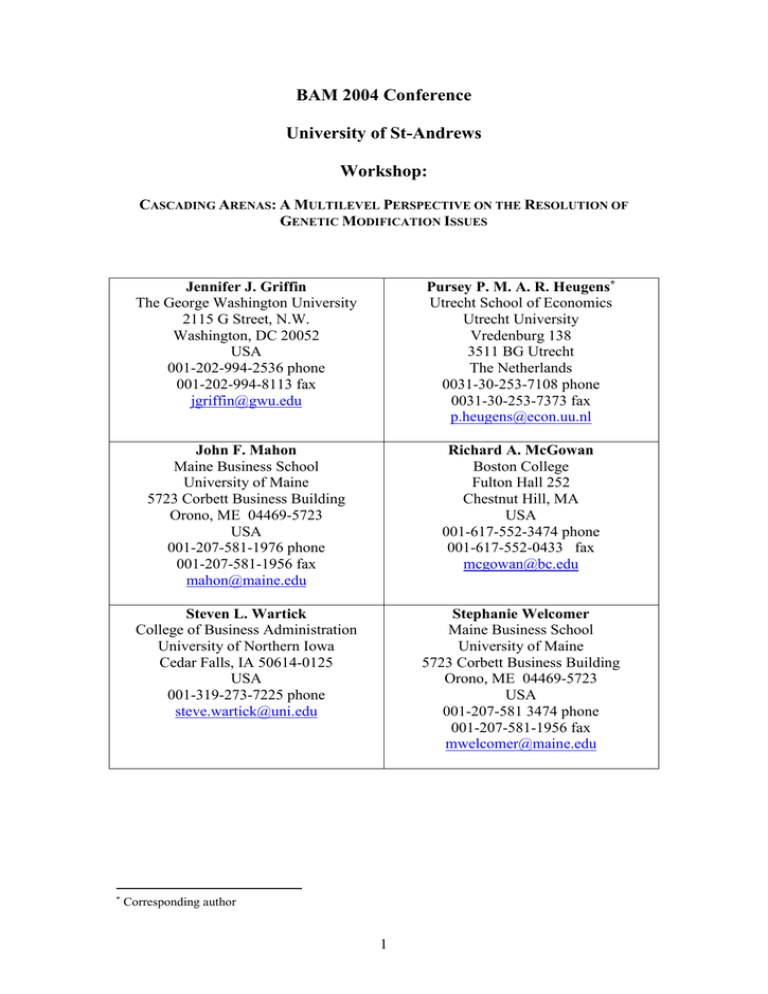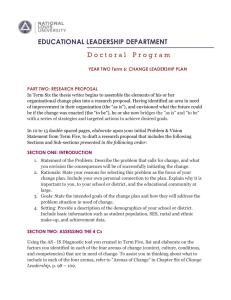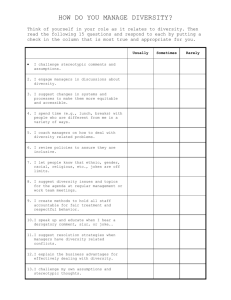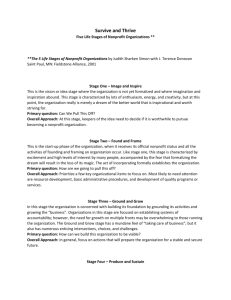BAM 2004 Conference University of St-Andrews Workshop:
advertisement

BAM 2004 Conference University of St-Andrews Workshop: CASCADING ARENAS: A MULTILEVEL PERSPECTIVE ON THE RESOLUTION OF GENETIC MODIFICATION ISSUES * Jennifer J. Griffin The George Washington University 2115 G Street, N.W. Washington, DC 20052 USA 001-202-994-2536 phone 001-202-994-8113 fax jgriffin@gwu.edu Pursey P. M. A. R. Heugens* Utrecht School of Economics Utrecht University Vredenburg 138 3511 BG Utrecht The Netherlands 0031-30-253-7108 phone 0031-30-253-7373 fax p.heugens@econ.uu.nl John F. Mahon Maine Business School University of Maine 5723 Corbett Business Building Orono, ME 04469-5723 USA 001-207-581-1976 phone 001-207-581-1956 fax mahon@maine.edu Richard A. McGowan Boston College Fulton Hall 252 Chestnut Hill, MA USA 001-617-552-3474 phone 001-617-552-0433 fax mcgowan@bc.edu Steven L. Wartick College of Business Administration University of Northern Iowa Cedar Falls, IA 50614-0125 USA 001-319-273-7225 phone steve.wartick@uni.edu Stephanie Welcomer Maine Business School University of Maine 5723 Corbett Business Building Orono, ME 04469-5723 USA 001-207-581 3474 phone 001-207-581-1956 fax mwelcomer@maine.edu Corresponding author 1 CASCADING ARENAS: A MULTILEVEL PERSPECTIVE ON THE RESOLUTION OF GENETIC MODIFICATION ISSUES Synopsis: In this workshop a new conceptual framework is developed for the analysis of societal and political issues with corporate implications. A key observation is that issues are often simultaneously discussed, debated, and debunked in what we will call cascading arenas: multiple interrelated socio-political fields of resolution. We use the cascading arena perspective to structure and analyze an international case study of the introduction and reception of genetically modified foods, based on data collected in the United States and the European Union. Presentation 1: Towards a new framework for issue analysis and resolution: Cascading arenas Issues management is a well-developed concept in the field of business and society (Bigelow et al., 1993; Mahon et al., 2004; Wartick & Mahon, 1994). Issues are raised by the firm or other actors that demand some sort of action and response. As an issue forms, stakeholders gather around the issue. They may have multiple motivations for involvement—ideology, revenge, substance—or be dragged into the issue by others. What is often neglected in such analyses, however, is the context in which issue contests take place. We call such contexts arenas, and define them as socially recognized “places” where issues are resolved. These “places” include the legislature, courts, arbitrators, mediators, and “the court of public opinion.” Scholars have begun to investigate how organizations and stakeholders select arenas for issue resolution (Cobb & Elder, 1972; Edelman, 1988; Mahon & McGowan, 1996, 1998). Their tentative conclusion is that arena selection is driven by an assessment as to where the stakeholder believes it has an advantage. What is missing in issue analysis is the movement across transnational and arena borders. In this first presentation we will propose a theoretical model of cascading arenas, addressing specifically three different arenas: local level (country level in EU, state level in US), regional level (EU & US), and transborder international issues (across trading NAFTA and EU). We note the broad characteristics of these arenas and address the processes by which issues migrate up and down and across such arenas over time, using the genetically modified organisms debate as an illustrative example of this process. We also offer insights for managers of organizations and public interest groups regarding strategies with regard to cascading arena use—addressing how issues migrate across arenas, tactics to block such migration, and how to deal with issues being debated simultaneously in multiple arenas. Presentation 2: Cascading arenas and genetic modification: The European case This second presentation addresses how the issue of genetic modification is perceived in four European arenas – Nordic, Germanic, Anglo, and Latin Europe. Each arena is characterized by a unique set of (a) stakeholders, (b) stakeholder interests, (c) issue resolution resources, and (d) sentiments with respect to issue resolution. Finland, Norway, Sweden, and Denmark constitute the Nordic block. Scandinavian people are relatively knowledgeable about biotechnology, and more likely than most to read articles/watch television programs on the topic (Eurobarometer, 2000). The dominant theme here is organic farming, where elements like “naturalness” of food production and knowledge of the origin of foods play important roles. Switzerland, Austria, and 2 Germany comprise Germanic Europe. Unlike other European regions, the Germanic people interpret genetic modification first as a political (rather than moral or technological) phenomenon. Germanic Europeans are more likely than most to sign a petition against modern biotechnology (Eurobarometer, 2000). In Europe’s Anglo block (United Kingdom and Ireland), there is controversy between the state and the public concerning the desirability of genetic modification. The UK’s New Labour government strongly supports modern biotechnology, mostly because it fits with the party’s pro-globalization rhetoric and represents a prime example of an of Industry that could be crucial to Britain’s economic future (Barry, 1999). France, Spain, Portugal, Italy, and Belgium belong to Latin Europe. Typically, European Latinos know fairly little about biotechnology, and most will readily admit that they have never discussed modern biotechnology with anyone (Eurobarometer, 2000). Presentation 3: Cascading arenas and genetic modification: The U.S. case In the US, four constituencies color the debate on genetic modification: business, environment, consumers, and government. Understanding the debate within these four dimensions provides a snapshot of the biotechnology issue. In the 1990’s, biotechnology began to cross industries and included chemicals, pharmaceuticals, agriculture, and biotechnology firms. Companies combined these businesses into “life sciences” (e.g. Monsanto, Novartis). Competitive advantage was sought through genetically engineered foods delivering health benefits, and lessening the use of pesticides in production. Profits largely depend on international trade regulations regarding biotechnology. European resistance has an impact on American growers who use modified crops and export to Europe. Selling modified crops does not end with access via trade arrangements, however. Consumer attitudes are also central. In the U.S., consumer attitudes are characterized as accepting or unaware. In either case, U.S markets have largely accepted the presence of modified food ingredients with little public outcry. Yet, consumers have registered concern about the presence of potentially dangerous allergens in foods not commonly associated with the food, with unknown risks, with containment of altered genes, and with risks to other species. Presentation 4: Cascading arenas of resolution: Managerial implications Within the portfolio of issues embedded in the biotechnology debate (Heugens, Mahon & Wartick, 2004), a wide range of arenas of resolution and targeted audiences exist. With multiple interests, varying levels of motivation, and differing resources to advance their positions, decision-makers have developed a complex calculus of issue definitions, issue arenas, and targeted audiences (Mahon & McGowan, 1996). In this closing presentation we examine the complex algorithm of costs and benefits including issue definition, timeliness, and information networks managers have created to support their offensive and defensive strategies across arenas of resolution. Implications for management are tied to the issue definitions, interests represented, and timing of resolution within each arena. Time sensitivity, issue life cycle, institutional audience, desire for resolution, information asymmetry, venue shopping, and broad vs. narrow positioning are each examined as important considerations in strategically managing transnational issues in cascading arenas of resolution. 3 REFERENCES Barry, J. 1998. GM food, biotechnology, risk and democracy in the UK: A sceptical green perspective. Keele University Working Paper. Bigelow, B., Fahey, L. and Mahon, J. 1993. A typology of issue evolution. Business & Society, 32: 18-29. Cobb, R. W., and Elder, C. D., 1973. Participation in American Politics: The Dynamics of Agenda Building. Boston, MA: Allyn and Bacon. Edelman, M. 1988. Constructing the Public Spectacle. Chicago and London: University of Chicago Press. Eurobarometer. 2000. The Europeans and Biotechnology. Brussels: DirectorateGeneral for Research of the European Union. Heugens, P.P.M.A.R., Mahon, J. F. and Wartick, S. 2004. A portfolio approach to issue adoption. Presented at the 15th annual International Association for Business and Society conference, March 2004. Mahon, J. F., Heugens, P. M. A. R., and Lamertz, K., 2004. Social Networks and Nonmarket Strategy. Journal of Public Affairs, 4(2): forthcoming. Mahon, J. F., and McGowan, R. A., 1996. Industry as a player in the political and social arena: defining the competitive environment. Westport, CT: Quorum Books. Mahon, J. F., and McGowan, R. A., 1998. Modeling industry political dynamics. Business and Society, 37, (4), December, 1998: 390 – 413. Wartick, S. L., and Mahon, J. F., 1994. Toward a substantive definition of the corporate issue construct: A review and synthesis of the literature. Business and Society, 33(3): 293–311. 4



